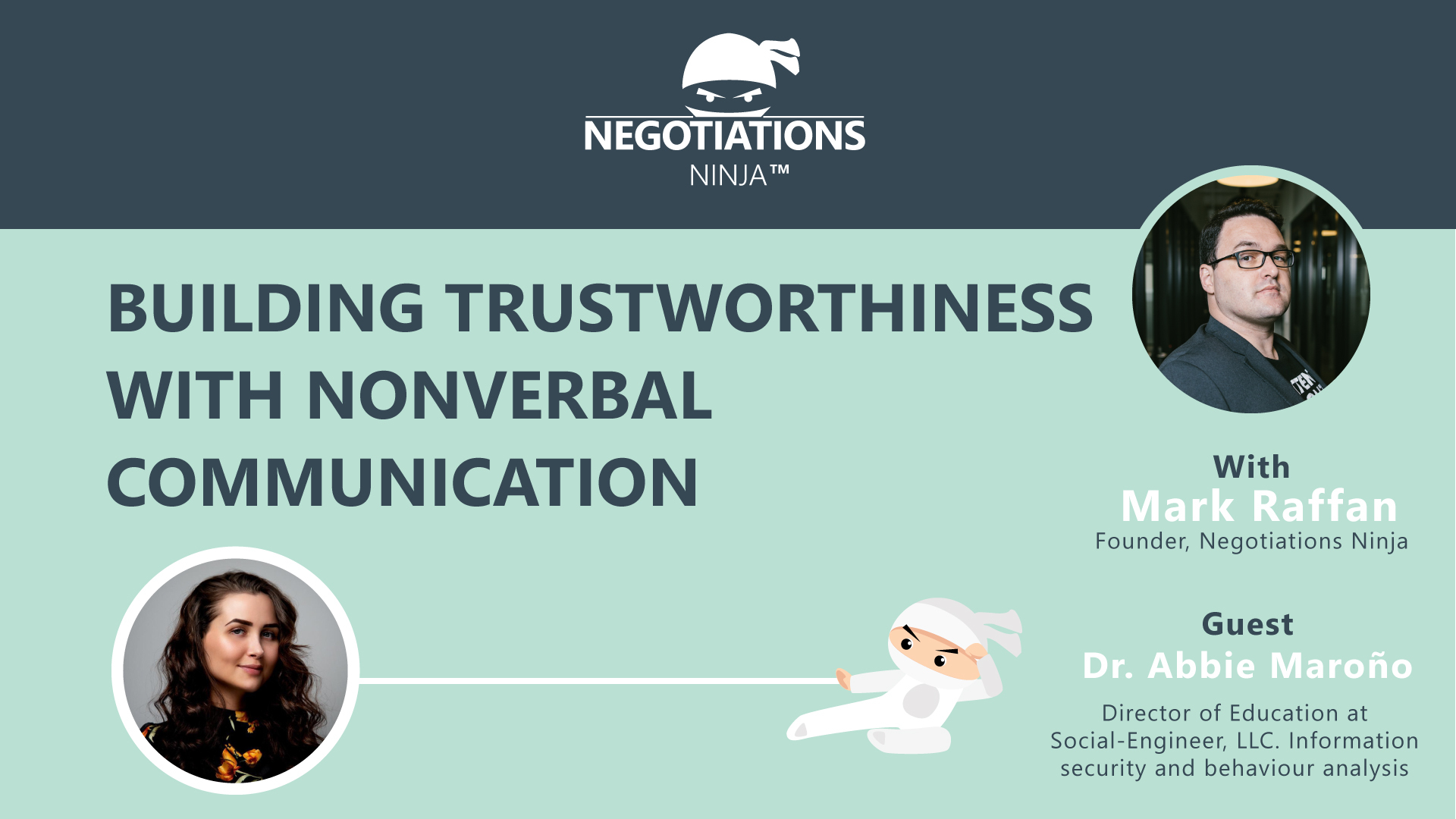How does nonverbal communication make or break a negotiation? How do you appear more trustworthy? What skills can you utilize to improve your nonverbal communication? In this episode of Negotiations Ninja, Abbie Moreno—who has a Ph.D. in Human Behavior—talks about the science behind nonverbal communication and how it drives trustworthiness.
Outline of This Episode
- [2:22] Learn all about Dr. Abbie Maroño, Ph.D.
- [3:26] Why can nonverbal communication make or break a negotiation?
- [5:16] Have we become worse at recognizing nonverbal cues?
- [7:53] The most outrageous claim that we’ve been taught to believe
- [9:40] Do personality traits correlate with nonverbal behavior?
- [14:55] How to appear more trustworthy to shortcut the process
- [21:22] The importance of emotional expressiveness
- [26:25] Does feigning disappointment work as a negotiation tactic?
- [29:13] Why trustworthiness signals need to become second-nature
- [32:30] How to get someone to want to reveal information
- [36:04] How to know if someone is skeptical of you
Why can nonverbal communication make or break a negotiation?
Non-verbal communication is make or break because it’s a language that everyone is unconsciously attuned to. No matter your culture, age, or gender, it’s a medium that we all communicate through.
When we can make the unconscious conscious and recognize what our bodies and faces are telling other people—as well as recognize what their body language is saying—it’s powerful. It gives us more control over our interactions.
How to appear more trustworthy
Nonverbal communication is one of the main ways that we communicate our trustworthiness. And trustworthiness judgments are unconsciously made within 33 milliseconds. That’s why you must enter an interaction appearing trustworthy. Once someone makes that judgment, they collect information to justify that judgment rather than looking for correct information.
Nonverbal communication gives you the power to make that first judgment positive. So how do you start?
Smile. Why? When we see a genuine smile, it releases oxytocin in the brain, which calms the fight or flight response in the amygdala. When you have cooperative interactions and perceive someone is trustworthy, there is increased oxytocin. When you see a smile, your brain releases oxytocin.
The importance of emotional expressiveness
There’s a misconception that you need to have a poker face, so you don’t give away your position in a negotiation. That’s wrong. Having a poker face decreases your sense of trustworthiness. You’re telling their brain that you’re hiding something and that you’re untrustworthy.
The biggest driver of perceived trustworthiness is emotional expressivity. Emotional expressivity is the driving factor of how we perceive if someone is trustworthy. But it has to be consistent with the emotion you’re talking about. You like to see people who are smiling and positive—but we also need to see empathy. If you’re talking about having a horrible day and the other person is smiling, it’s incongruent.
How to know if someone is skeptical of you
Research on trustworthy behavior and nonverbal communication found that if someone is skeptical after an interaction and is unlikely to trust you, they showed more:
- Face touching
- Crossing of the arms
- Leaning backward
- Touching hands together
If you see those behaviors, it could indicate skepticism. But if you take the time to stop and address them, you can reduce the lack of trust. You need to address these behaviors as quickly as possible.
Can appearing trustworthy be practiced and mastered?
We can make our behaviors more unconscious. It’s like learning a language. When you first say new words, it might sound robotic. But as you become more fluent, they become second nature. It’s the same with nonverbal communication.
If you want to display trustworthiness, you might use more open-palm gestures and be more expressive. The more you practice it, the more it becomes second nature. But Dr. Maroño is careful to note that these aren’t tools to take out and utilize as you need them—they need to be embedded in the way you communicate. It needs to become second nature.
That being said, if you want to express sadness, think about something that makes you sad. If you’re nervous, listen to a song that makes you feel confident. If you know, you want to leverage disappointment, think about or listen to something sad or disappointing that gets you into that mindset.
How do you get someone to want to reveal information? Listen to the whole episode to learn more about building trustworthiness through nonverbal communication.
Connect with Dr. Abbie Maroño
Connect With Mark
- Follow Negotiations Ninja on Twitter: @NegotiationPod
- Connect with Mark on LinkedIn
- Follow Negotiations Ninja on LinkedIn
- Connect on Instagram: @NegotiationPod




